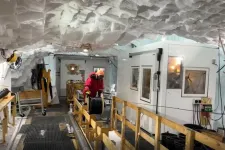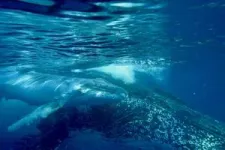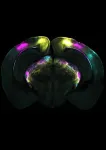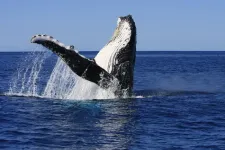(Press-News.org) In brief:
• In Greenland, an international team of researchers led by ETH Zurich has discovered that countless tiny ice quakes take place deep inside ice streams.
• These quakes are responsible for the fact that ice streams also move with a continuous stick-slip motion and not only like viscous honey as previously considered.
• The researchers recorded seismic data from inside the ice stream using a fibre-optic cable in a 2,700-metre deep borehole.
The great ice streams of the Antarctic and Greenland are like frozen rivers, carrying ice from the massive inland ice sheets to the sea – and a change in their dynamics will contribute significantly to sea-level rise. In order to estimate just how much sea levels will rise, climate researchers rely on computer simulations of the ice streams. Until now, they have based these simulations on an assumption that the ice streams flow slowly but steadily into the sea like thick honey.
However, satellite measurements of the flow speed of ice streams show that such simulations are inaccurate and have shortcomings to correctly reflect reality. This leads to considerable uncertainties in estimates of how much mass the ice streams are losing and how quickly and how high sea levels will rise.
Ice streams both judder and flow
Now, a team of researchers led by ETH professor Andreas Fichtner has made an unexpected discovery: deep within the ice streams, there are countless weak quakes taking place that trigger one another and propagate over distances of hundreds of metres. This discovery helps to explain the discrepancy between current simulations of ice streams and satellite measurements, and the new findings should also impact the way ice streams are simulated in the future.
“The assumption that ice streams only flow like viscous honey is no longer tenable. They also move with a constant stick-slip motion,” says Fichtner. The ETH professor is confident that this finding will be integrated into simulations of ice streams, making estimates of changes in sea level more accurate.
Riddles relating to ice cores resolved
Moreover, the ice quakes explain the origin of numerous fault planes between ice crystals in ice cores obtained from great depths. These fault planes are the result of tectonic shifts and have been known to scientists for decades, although no explanation had been found for them until now.
“The fact that we’ve now discovered these ice quakes is a key step towards gaining a better understanding of the deformation of ice streams on small scales,” explains Olaf Eisen, Professor at the Alfred Wegener Institute and one of the study’s co-authors.
The study by this international research team led by ETH Zurich has just been published in the journal Science and also involved researchers from the Alfred Wegener Institute, Helmholtz Centre for Polar and Marine Research (AWI), the University of Strasbourg, the Niels Bohr Institute (NBI), the Swiss Federal Institute WSL and other universities.
Fire and ice are related
The fact that these ice quakes cannot be observed at the surface and have therefore remained undiscovered until now is due to a layer of volcanic particles located 900 metres below the surface of the ice. This layer stops the quakes from propagating to the surface. Analysis of the ice core showed that these volcanic particles originate from a massive eruption of Mount Mazama in what is now Oregon (USA) some 7,700 years ago. “We were astonished by this previously unknown relationship between the dynamics of an ice stream and volcanic eruptions,” Fichtner recalls.
The ETH professor also noticed that the ice quakes start from impurities in the ice. These impurities are also leftovers from volcanoes: tiny traces of sulphates that entered the atmosphere in volcanic eruptions and flew halfway around the world before being deposited on the Greenland ice sheet in snowfall. These sulphates reduce the stability of the ice and favour the formation of microfissures.
A 2,700-metre borehole in the ice
The researchers discovered the ice quakes using a fibre-optic cable that was inserted into a 2,700-metre-deep borehole and recorded seismic data from inside a massive ice stream for the first time. This borehole was drilled into the ice by researchers from the East Greenland Ice-core Project (EastGRIP), led by the Niels Bohr Institute and strongly supported by the Alfred Wegener Institute, resulting in the extraction of a 2,700-metre-long ice core. Once drilling work was complete, the researchers took the opportunity to lower a fibre-optic cable 1,500 metres into the borehole and record signals from inside the ice stream continuously for 14 hours.
The research station and borehole are located on the North East Greenland Ice Stream (NEGIS), around 400 kilometres from the coast. The NEGIS is the biggest ice stream of the Greenland ice sheet, whose retreat is a large contributor to current rising sea levels. In the area of the research station, the ice is moving towards the sea at a speed of around 50 metres per year.
As ice quakes occur frequently over a wide area in the researchers’ measurements, ETH researcher Fichtner believes it is also plausible that they occur in ice streams everywhere, all the time. To verify this, however, it will be necessary to take seismic measurements of this kind in other boreholes – and there are already plans to do just that.
###
References
Fichtner A, Hofstede C, Kennett B L N, Svensson A, Westhoff J, Walter F, Ampuero J-P, Cook E, Zigone D, Jansen D, Eisen O, Hidden cascades of seismic ice stream deformation. Science. 6.2.2025, DOI: 10.1126/science.adp8094
END
Ice streams move due to tiny ice quakes
Dynamics of Greenland’s ice decrypted
2025-02-06
ELSE PRESS RELEASES FROM THIS DATE:
Whale song has remarkable similarities to human speech in terms of efficiency
2025-02-06
Whale song can be as efficient as – and, in some cases, more efficient than – human communication, according to a new study in Science Advances. Meanwhile, new unrelated research in Science further investigates whale song’s adherence to a universal linguistic law, as observed in recordings of humpback whales.
Natural selection favors the pithy over the longwinded. For example, yelling “Duck!” is faster and far more effective than shouting “Be careful, there is an incoming projectile, and you need to move out of the way!” ...
Uncovered: How mice override instinctive fear responses
2025-02-06
Researchers have uncovered a neural mechanism in the brains of mice that enables them to override instinctive fear responses; dysfunction in this mechanism may contribute to inappropriate or excessive fear responses, they say. According to the findings, targeting these circuits could offer new therapeutic avenues for treating fear-related disorders like post-traumatic stress disorder and anxiety. Fear responses to visual threats, such as escaping from an approaching predator, are critical instinctive reactions for survival and are ...
A pathway that contributes to insulin resistance can be targeted, mouse study shows
2025-02-06
The hormone adrenomedullin disrupts insulin signaling in blood vessel cells, contributing to systemic insulin resistance in obesity-associated type 2 diabetes, according to a new study. Blocking adrenomedullin’s effects restores insulin function and improves glucose control in a mouse model, suggesting a potential new target for treating obesity-related metabolic disease. Diabetes is a leading global cause of illness, mortality, and healthcare expenditures, with most cases stemming from obesity-induced insulin resistance and type 2 diabetes mellitus. Insulin resistance primarily ...
Special Issue: The cryosphere
2025-02-06
In this Special Issue of Science, 3 Reviews and a Policy Forum highlight research on Earth’s frozen places – from the Arctic to the Antarctic – and how it’s changing due to climate change and the geopolitical challenges this important work faces. In the first Review, Julienne Stroeve and colleagues provide a preview of what the Arctic region may look like in a warmer world. Without stronger climate action, global temperatures are set to rise +2.7°C above preindustrial levels, ...
Scientists discover brain mechanism that helps overcome fear
2025-02-06
Researchers at the Sainsbury Wellcome Centre (SWC) at UCL have unveiled the precise brain mechanisms that enable animals to overcome instinctive fears. Published today in Science, the study in mice could have implications for developing therapeutics for fear-related disorders such as phobias, anxiety and post-traumatic stress disorder (PTSD).
The research team, led by Dr Sara Mederos and Professor Sonja Hofer, mapped out how the brain learns to suppress responses to perceived threats that prove ...
Mantis shrimp clubs filter sound to mitigate damage
2025-02-06
Known for their powerful punch, mantis shrimp can smash a shell with the force of a .22 caliber bullet. Yet, amazingly, these tough critters remain intact despite the intense shockwaves created by their own strikes.
Northwestern University researchers have discovered how mantis shrimp remain impervious to their own punches. Their fists, or dactyl clubs, are covered in layered patterns, which selectively filter out sound. By blocking specific vibrations, the patterns act like a shield against self-generated shockwaves.
The study will be published on Friday (Feb. 7) in the journal Science.
The findings someday could be applied to developing ...
Large differences in water-seeking ability found in U.S. corn varieties
2025-02-06
A corn plant knows how to find water in soil with the very tips of its roots, but some varieties, including many used for breeding high-yielding corn in the U.S., appear to have lost a portion of that ability, according to a Stanford-led study. With climate change increasing droughts, the findings hold potential for developing more resilient varieties of corn.
The study, published in the journal Science, uncovers genetic mechanisms behind root “hydropatterning,” or how plant roots branch toward water and avoid dry spaces in soil. In particular, the researchers ...
Whale song has structure similar to human language
2025-02-06
Humpback whale song is a striking example of a complex, culturally transmitted behavior, but up to now, there was little evidence it has language-like structure. Human language, which is also culturally transmitted, has recurring parts whose frequency of use follows a particular pattern. In humans, these properties help learning and may come about because they help language be passed from one generation to the next. This work innovatively applies methods inspired by how babies discover words in speech to humpback whale recordings, uncovering the same statistical structures found in all human languages. It reveals previously undetected structure in ...
Cracking the Burmese python code: New data zeroes in on game-changing strategies
2025-02-06
In a groundbreaking study, University of Florida scientists statistically analyzed large amounts of data collected by Burmese python contractors, revealing critical insights about how to most efficiently remove the reptiles.
Researchers correlated survey outcomes, including python removals, with survey conditions, using statistical modeling. For example, the researchers examined if factors like time or temperature impacted the chance of removing a python. They also analyzed whether the most surveyed areas aligned with the highest python removals. This allowed the researchers to ...
Risk it or kick it? Study analyzes NFL coaches’ risk tolerance on fourth down
2025-02-06
During the Super Bowl, every decision matters. With millions of fans watching, the game often comes down to a single play call. And no call is more scrutinized than what a coach decides to do on fourth down. Punt? Attempt a field goal? Or go for it?
A new BYU study explains why NFL coaches, including Super Bowl contenders Andy Reid (Kansas City Chiefs) and Nick Sirianni (Philadelphia Eagles), may behave too conservatively on fourth down. Despite growing acceptance of analytics-driven decision-making, most coaches, ...
LAST 30 PRESS RELEASES:
University of Oklahoma researcher awarded funding to pursue AI-powered material design
Exploring how the visual system recovers following injury
Support for parents with infants at pediatric check-ups leads to better reading and math skills in elementary school
Kids’ behavioral health is a growing share of family health costs
Day & night: Cancer disrupts the brain’s natural rhythm
COVID-19 vaccination significantly reduces risk to pregnant women and baby
The role of vaccination in maternal and perinatal outcomes associated with COVID-19 in pregnancy
Mayo Clinic smartwatch system helps parents shorten and defuse children's severe tantrums early
Behavioral health spending spikes to 40% of all children’s health expenditures, nearly doubling in a decade
Digital cognitive behavioral treatment for generalized anxiety disorder
Expenditures for pediatric behavioral health care over time and estimated family financial burden
Air conditioning in nursing homes and mortality during extreme heat
The Alps to lose a record number of glaciers in the next decade
What makes a good proton conductor?
New science reporting guide published for journalists in Bulgaria
New international study reveals major survival gaps among children with cancer
New science reporting guide published for journalists in Turkey
Scientists develop a smarter mRNA therapy that knows which cells to target
Neuroanatomy-informed brain–machine hybrid intelligence for robust acoustic target detection
Eight SwRI hydrogen projects funded by ENERGYWERX
The Lundquist Institute and its start-up company Vitalex Biosciences Announces Strategic Advancement of Second-Generation fungal Vaccine VXV-01 through Phase 1 Trials under $40 Million Competitive Con
Fine particles in pollution are associated with early signs of autoimmune disease
Review article | Towards a Global Ground-Based Earth Observatory (GGBEO): Leveraging existing systems and networks
Penn and UMich create world’s smallest programmable, autonomous robots
Cleveland researchers launch first major study to address ‘hidden performance killer’ in athletes
To connect across politics, try saying what you oppose
Modulating key interaction prevents virus from entering cells
Project explores barriers to NHS career progression facing international medical graduates
Jeonbuk National University researchers explore the impact of different seasonings on the flavor perception of Doenjang soup
Two Keck Medicine of USC Hospitals named Leapfrog Top Teaching Hospitals
[Press-News.org] Ice streams move due to tiny ice quakesDynamics of Greenland’s ice decrypted








